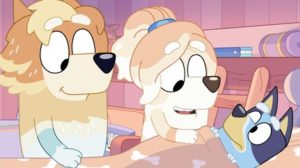In “Double Babysitter” (s2 e39), Bluey is skeptical about having a babysitter put her to bed. The reason that she’s able to give right away is that it’s just “different” from when Mum and Dad do it. Mum and Dad reassure her, and confidently leave them with the babysitters anyway. At first, the babysitters try to solve the problem of them being “different” by promising to do everything the same, but of course it doesn’t work: they don’t know the games that Dad plays or how to do everything exactly like him.
Later, she begs the babysitters not to watch TV after she goes to sleep and they realize the real problem. Last time Bluey had a babysitter, it was Grandma, who watches TV with the sound turned way up. She watched a scary movie, not realizing that Bluey could hear it in her bed and was scared. The babysitters promise not to watch any TV, and they uphold their promise.

Everything about this is an amazing case study for Dr. Ross Greene’s “Collaborative/Proactive Solutions” or “Collaborative Problem Solving” (CPS) method. You may have heard of it before if you’ve read any of his books, like “Raising Human Beings”, “The Explosive Child” or “Lost at School” — each one is just a slightly different style of laying out the method of how to connect with a child, hear their concerns about something they’re struggling with, lay out your adult concerns, and find a mutually agreeable solution. He calls this concept “Plan B” — as in, Plan A is where the adults just unilaterally make a decision and enforce it upon the child without caring whether it works for the child or not, but Plan B is collaborating together for a solution.
Bluey highlights some important aspects of this type of problem-solving in the episode. First of all, she doesn’t know what her exact concern is. She’s only 6 and may or may not even remember specifically why she was scared and upset the last time a babysitter was there. Maybe she was dozing off as she was listening to the scary show, and it gave her bad dreams or anxious feelings but she couldn’t quite name why until something made her remember: the act of the babysitters putting her to bed was what made her remember. She wasn’t lying when she said they just put her to bed “different” than Mum and Dad — that was perfectly true. It just wasn’t specific enough to be actionable.
An adult who knows Collaborative Problem Solving could talk a bit more with Bluey and figure out what it is that’s “different” to try to get to the heart of the problem and figure out a solution! It probably wouldn’t have occurred to an adult that the problem was “previous babysitter watched scary TV too loud”, nor that the solution was as simple as “don’t watch TV”. Collaborative problem solving is often full of these surprises. Adults are quick to assume we know exactly what our child’s problem is (and adults are often self-obsessed enough to assume that our child’s problem is that they’re just trying to “defy” or “test” or “annoy” us 😉 ) and therefore that we unilaterally know what the solution should be. But hearing our kids’ concerns might surprise us with what we find out.
Another thing that I appreciate about this episode and is worth commenting on is that Bluey’s parents still go out. They trust the babysitters they’re leaving her with and they trust in Bluey’s resilience and ability to articulate her concerns. With true collaborative problem-solving, depending on the child and the scenario, it might have been more appropriate for them to sit down with her before leaving the house and dig into what it was that was really concerning her. But in this specific instance, I think they made the right choice. They were leaving her with trusted and experienced adults who also listen to the kids and respect them. They knew she would be safe.
The last thing I like is that the adults actually uphold the solution as stated by the child. Bluey asks them not to watch TV at all. They could have argued that instead they would just promise to watch TV quietly, or watch TV but not scary TV. Or, they could have lied to her, promised not to watch it, and then snuck out and watched TV quietly anyway. These would all have just taught her that she couldn’t trust those adults. But if there was some reason why her solution (don’t watch TV) wouldn’t work, they could have kept on collaborating until they figured out a mutually acceptable solution.


